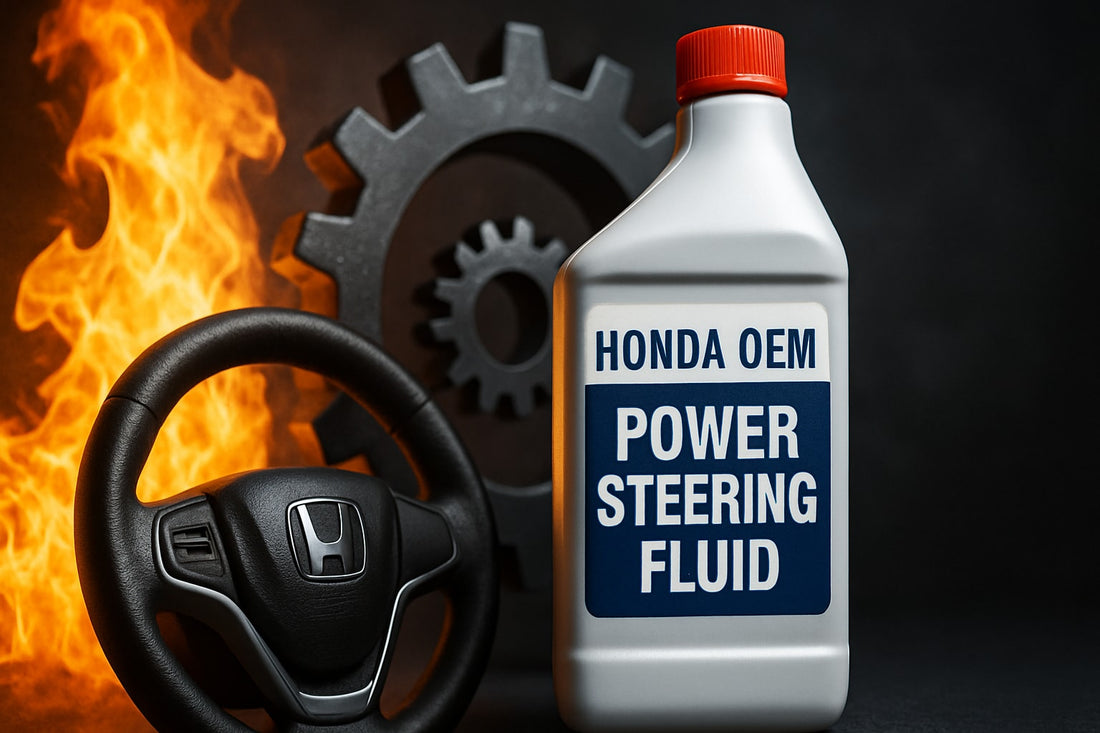
Honda OEM Power Steering Fluid Guide 2025: Application & Tips
Share
Choosing the right power steering fluid is essential for the safety and longevity of your Honda. Choosing the wrong product risks expensive damage and reduced steering precision.
That's why this guide shows why only Honda OEM power steering fluid is recommended, how to use it correctly, and which tips are especially important in 2025.
You'll learn how this fluid differs from universal products, receive step-by-step instructions for changing it, and learn which maintenance instructions you need to follow. Avoid mistakes and benefit from expert recommendations for a long-lasting steering system.
What is Honda OEM Power Steering Fluid?
Choosing the right power steering fluid is crucial for the proper function and longevity of every Honda steering system. The term "Honda OEM power steering fluid" refers to a fluid specially developed by Honda that is precisely tailored to the requirements and materials of Honda models.
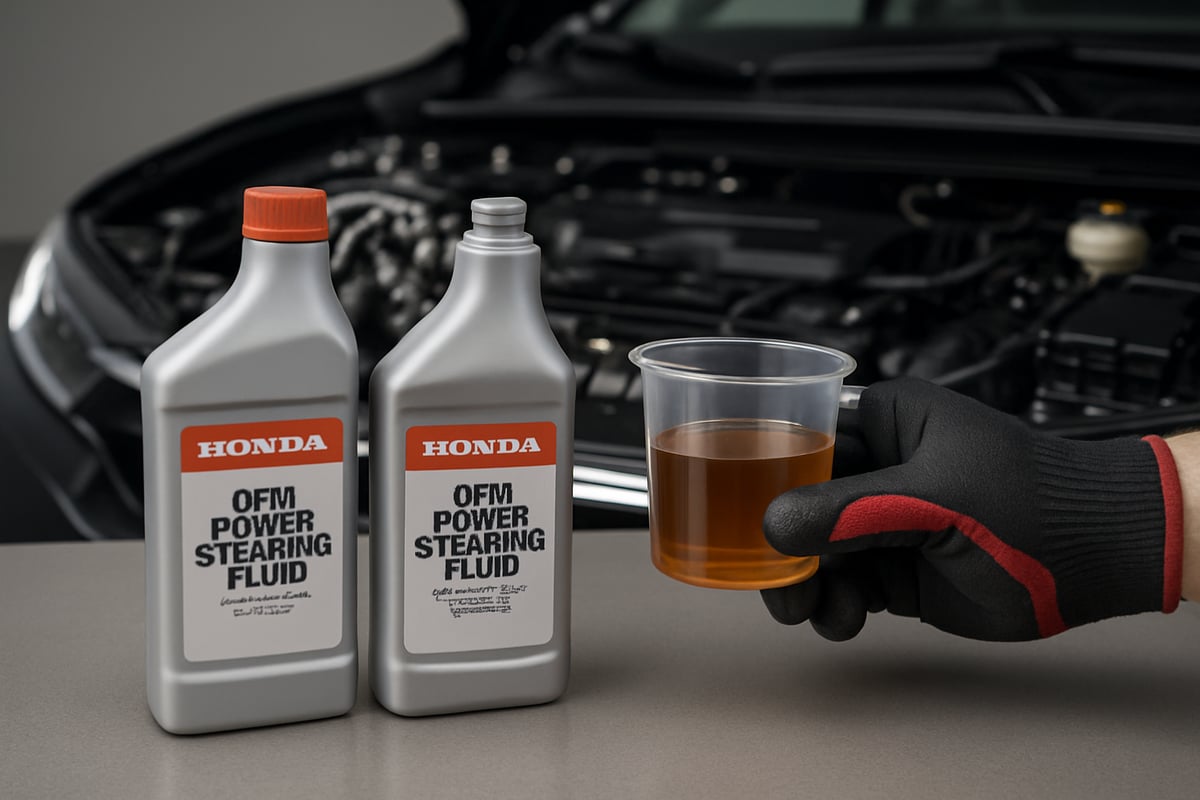
Definition and properties
OEM stands for "Original Equipment Manufacturer." This means that Honda OEM power steering fluid is developed and produced directly by Honda to meet the exact specifications of the steering systems of all Honda vehicles.
The composition of this fluid differs significantly from universal alternatives. Honda uses special additives that prevent corrosion, protect seals, and ensure optimal viscosity even at extreme temperatures. This precise blend ensures precise and smooth steering.
A comparison between OEM and universal fluids shows the most important differences:
| feature | Honda OEM Power Steering Fluid | Universal liquid |
|---|---|---|
| viscosity | Optimal for Honda systems | Varies, often too thick/thin |
| Additive | Specially for Honda materials | General, less targeted |
| Material compatibility | 100% matched | Risk for seals |
| Manufacturer approval | And | Usually no |
Honda recommends the exclusive use of Honda OEM power steering fluid, as many components such as seals and hoses can react sensitively to other products. Official part numbers, such as 08206-9002A, guarantee the correct selection for your model. The fluid is available in various packaging sizes, suitable for maintenance or refilling. An overview of available variants, part numbers, and compatibility can be found in the Honda OEM Power Steering Fluid Product Overview.
For current Honda models, including the 2025 generation, the use of OEM fluid is mandatory, according to the manufacturer. This is the only way to maintain steering precision and avoid expensive consequential damage.
Risks from incorrect power steering fluid
Using an unsuitable power steering fluid can have serious consequences. Universal products or other brands are often not tailored to the specific requirements of the Honda OEM power steering fluid and lead to increased wear.
Common damages caused by incorrect filling include:
- Leaks in seals and hoses
- Noise when moving the steering wheel
- Servo pump failure
Workshops regularly report cases where leaks or even complete failures of the power steering system occur due to incorrect fluid. Repair costs can quickly reach several hundred euros, especially if the pump or steering gear need to be replaced.
Another important point: The Honda warranty is generally void if the original Honda OEM power steering fluid is not used. Manufacturers and specialist workshops explicitly point out that only the OEM specifications ensure long-term protection of the system. Those who cut corners here not only risk expensive damage but also the loss of important warranty claims.
Application: Step-by-step instructions for changing
Changing the Honda OEM power steering fluid is a crucial maintenance step for the longevity and performance of your Honda steering system. Proper performance prevents damage and maintains optimal steering precision. Below you'll find a structured, step-by-step guide to guide you safely through the entire process.
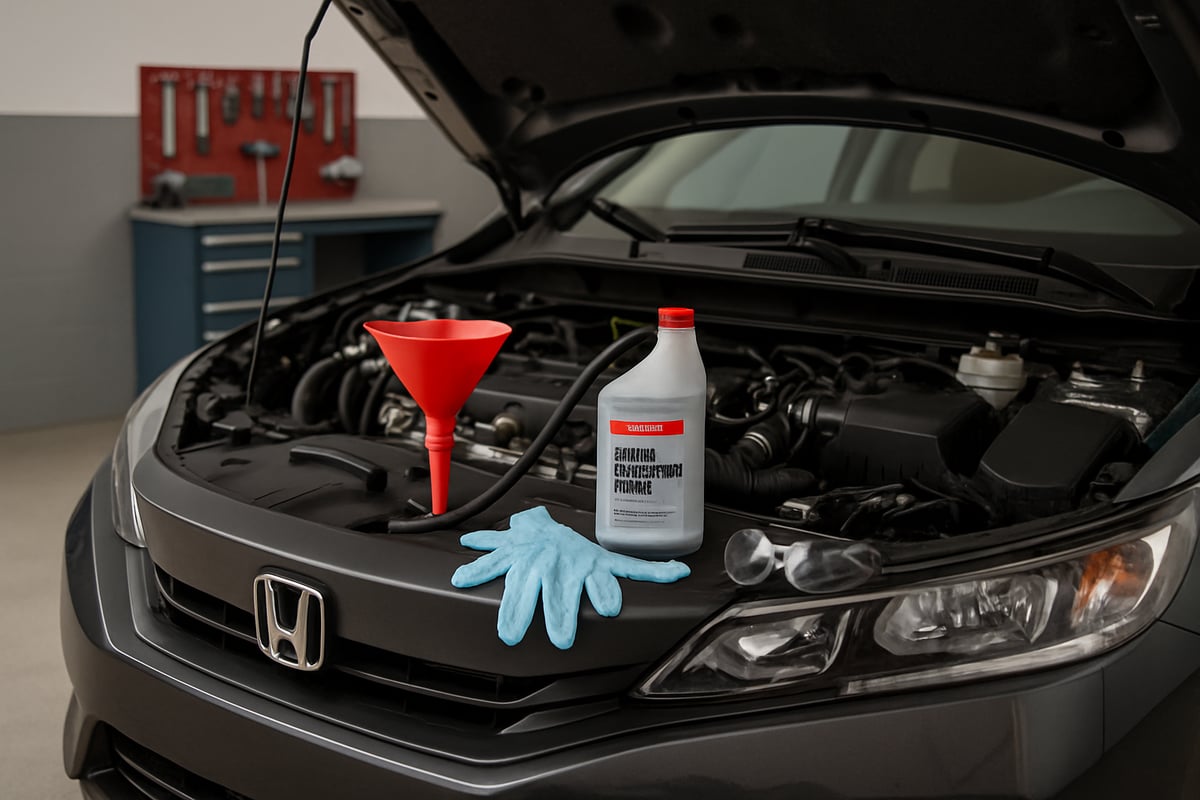
Preparation and safety
Before changing the Honda OEM power steering fluid, ensure a safe work environment. Gather the following tools: a drain pan, funnel, hose, gloves, safety goggles, a jack, and jack stands. Ensure you use only genuine Honda OEM power steering fluid. Allow the engine to cool completely and secure the vehicle against rolling.
Always work on a level surface to minimize the risk of accidents. Protect your hands and eyes with appropriate protective equipment. Check your vehicle's owner's manual for specific instructions on changing the power steering fluid. Detailed step-by-step instructions can also be found at Instructions for changing Honda Power Steering Fluid.
Drain old fluid
Locate your Honda's expansion tank and power steering pump. Place a drain pan underneath the reservoir to drain the old Honda OEM power steering fluid. Either use a siphon pump or disconnect the lower hose on the reservoir to allow the fluid to drain completely.
Be careful not to let any fluid get onto the paintwork or into the environment. Used oil must be disposed of in an environmentally friendly manner; workshops or recycling centers usually accept this fluid. After draining, check for any residue remaining in the system.
Clean and check the system
For optimal performance, it's recommended to flush the system after draining the old Honda OEM power steering fluid. Add a small amount of fresh fluid, let it circulate briefly, and then drain it again. Then check all hoses and seals for leaks or wear.
Thoroughly clean the expansion tank with a lint-free cloth. Make sure no foreign matter enters the system. This will ensure the new fluid can work optimally.
Fill with new Honda OEM fluid
Now slowly pour the manufacturer's recommended amount of Honda OEM power steering fluid into the reservoir. Use a clean funnel to avoid contamination. Monitor the level closely, paying attention to the markings on the reservoir.
Bleed the system by turning the steering wheel from lock to lock several times with the engine off. Check the fluid level again and top up if necessary. Repeat this process until no more air bubbles are visible and the level remains stable.
Functional test and follow-up check
Start the engine and observe the steering behavior. Listen for any unusual noises or stiffness, which could indicate a problem with the Honda OEM power steering fluid. After a short test drive, check the fluid level again and top up if necessary.
Check the system regularly for leaks over the next few days. This will ensure that the Honda OEM power steering fluid can continue to provide its protective and lubricating properties, ensuring your Honda remains optimally steerable.
Maintenance, change intervals & care tips
Regular power steering maintenance is essential for the safety and longevity of your Honda. Using Honda OEM power steering fluid contributes significantly to keeping the steering system efficient and reliable over time. Following the service intervals and maintenance instructions can prevent damage and significantly extend the service life of the steering system.
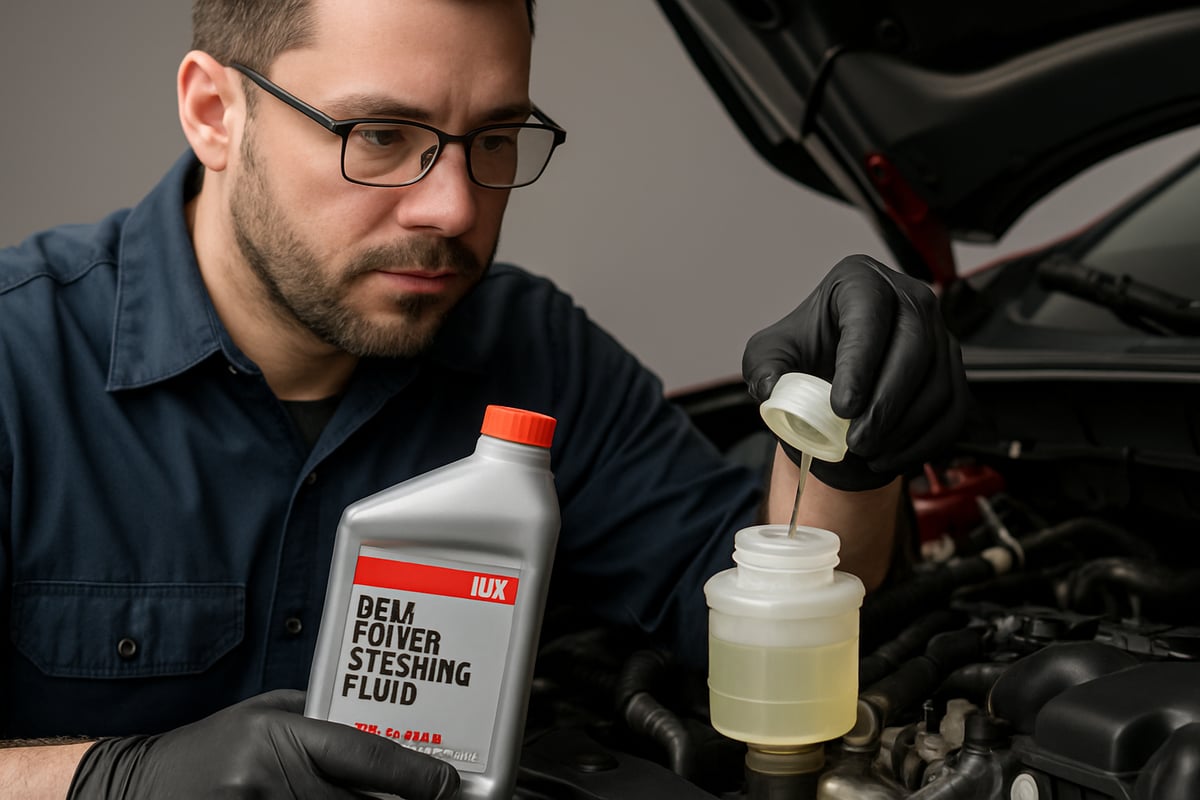
Change intervals according to Honda recommendations
Honda recommends changing the Honda OEM power steering fluid on most models at least every 60,000 kilometers or every four years. For older vehicles or vehicles with intensive use, such as those in mountainous regions or with frequent short-distance driving, an earlier change may be advisable.
The intervals are selected so that the additives in the Honda OEM power steering fluid are fully effective and protect the steering system from wear. Exceeding these intervals risks deposits and reduced lubrication, which can lead to damage to the pump or steering gear.
Regularly changing your Honda OEM power steering fluid ensures consistently precise steering and extends the life of all components. Always follow the instructions in your vehicle's service manual and adjust your maintenance schedule as needed under difficult conditions.
Typical signs of aging or problematic fluid
There are clear warning signs that indicate aging or unsuitable power steering fluid. Typical examples include unusual steering noises, such as squeaking or rattling. Steering stiffness or delayed response also indicate that the Honda OEM power steering fluid needs to be replaced.
A change in the fluid color in the expansion tank, for example, from clear to dark brown, or the formation of foam are also warning signs. Workshop reports show that neglected or incorrect fluid often leads to leaks and premature seal wear.
Field reports confirm that a timely switch to Honda OEM power steering fluid prevents many of these problems. Paying attention to these symptoms can prevent major damage and ensure the operational reliability of your Honda.
Care tips for a long-lasting steering system
Regular visual inspection of the fluid level is essential. When refilling, use only Honda OEM Power Steering Fluid to ensure material compatibility and optimal function. Be careful not to overfill or underfill, as both can impair steering performance.
Regularly check all hoses and seals for leaks. This is especially important in winter, as temperature fluctuations can affect the properties of the power steering fluid.
Further practical advice, step-by-step instructions and experience reports on the maintenance and care of the Honda OEM power steering fluid can be found in the Honda Power Steering Fluid BlogThis way, you'll always stay up to date and effectively protect your steering system.
Typical mistakes and how to avoid them
Mistakes when handling Honda OEM power steering fluid can have serious consequences. Failure to perform maintenance or replacement correctly risks expensive damage and compromised safety and driving comfort. Therefore, it's especially important to be aware of common mistakes and avoid them.
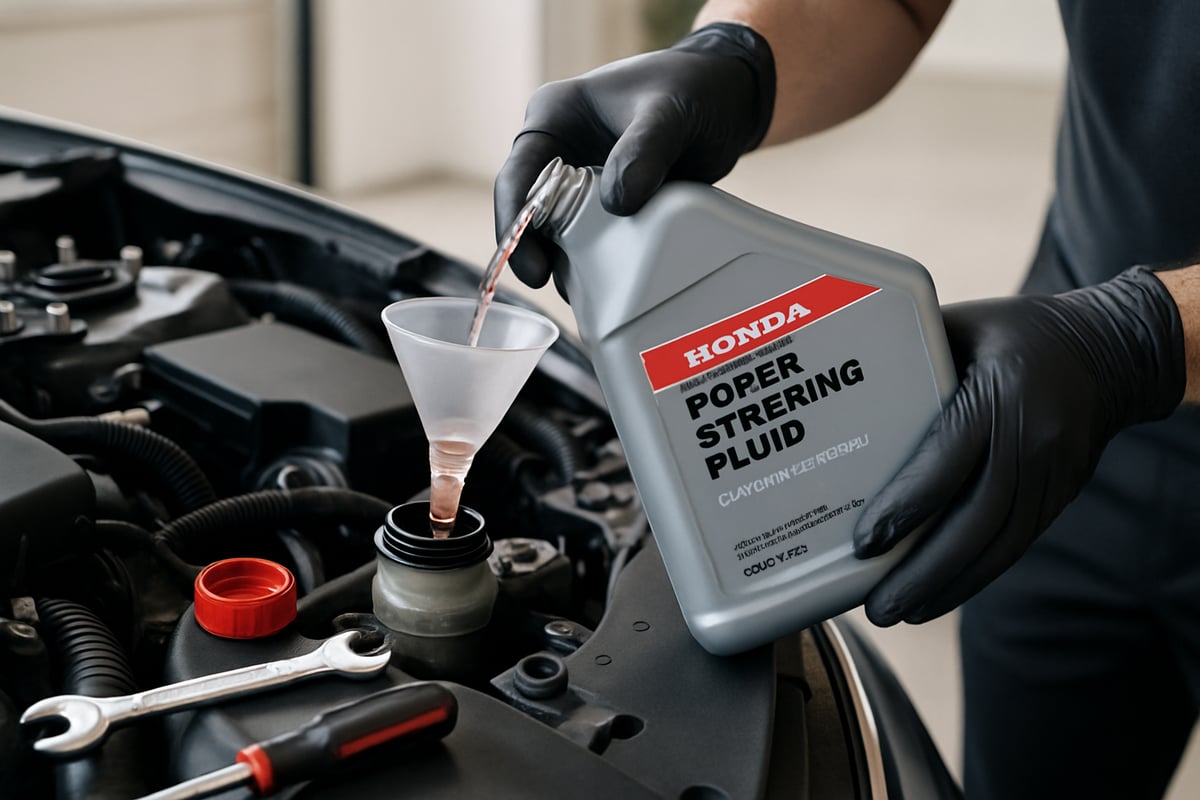
Common mistakes when changing and refilling
Many Honda owners underestimate the importance of changing Honda OEM power steering fluid correctly. Even small deviations can compromise the entire steering system.
Typical errors are:
- Use of non-approved or universal fluids
- Overlooking leaks, porous hoses or defective seals
- Working too quickly or improperly, causing air to enter the system
- Incorrect filling quantity or mixing of different liquids
A common misconception is that universal power steering fluids are compatible. In fact, Honda models are specifically formulated for Honda OEM power steering fluid. Choosing a different fluid risks incompatibilities that often only become apparent after months.
Neglecting to check for leaks after a change is also a common mistake. Even small leaks can lead to a gradual loss of fluid and cause significant long-term damage.
Consequences of errors
The consequences of improper use of Honda OEM power steering fluid range from minor malfunctions to major damage to the steering system. Particularly critical: damage to the power steering pump, leaking seals, or even failure of the steering assistance.
Using the wrong fluids risks additives and viscosity that aren't compatible with the materials used. This results in swelling of seals, cracks, and leaks. Air pockets caused by improper handling lead to noise, stiff steering, or delayed response.
In addition to the technical consequences, there are also costs. A defective pump or a leaking circuit often result in repairs in the four-figure range. Furthermore, the manufacturer's warranty can be voided if it can be proven that non-Honda OEM power steering fluid was used.
Expert tips for avoiding mistakes
To avoid errors, it is recommended to pay attention exclusively to the OEM specifications and work step by step according to the manufacturer's instructions. Prepare all tools and materials, ensure cleanliness, and check the fluid level and system for leaks after each change.
Perform a functional test after each change. Move the steering wheel from lock to lock several times to purge any air from the system. If you are unsure or lack experience, it's worth visiting a specialist workshop.
An overview of the advantages and universal application of OEM Honda PSF-S Power steering oil Find online to ensure you always use the right product for your model. This will ensure your steering system remains reliable and long-lasting.
OEM vs. Universal Power Steering Fluid: A Comparison
Choosing between Honda OEM power steering fluid and universal power steering fluid is a crucial factor in the longevity and safety of your Honda. Many vehicle owners question whether there really is a difference. Below, we highlight the most important technical and economic differences, provide an outlook for 2025, and demonstrate why using the original product is recommended.
Technical differences in detail
OEM power steering fluids like Honda OEM Power Steering Fluid are specifically developed for the requirements of Honda steering systems. They contain precisely matched additives and have a viscosity that is optimally matched to materials, seals, and the hydraulic pump.
In comparison, universal products are often broader in scope and may contain additives that are not fully compatible with Honda components. This can lead to premature wear, hardening of the seals, or even leaks.
| Property | Honda OEM Power Steering Fluid | Universal Fluid |
|---|---|---|
| Additive | Honda-specific | General |
| viscosity | Model optimized | Varying |
| Material compatibility | High | Restricted |
| compatibility | 100% Honda | Partially |
Field reports and workshop tests confirm that Honda OEM Power Steering Fluid ensures consistently precise steering. Further technical details can also be found at Honda OEM Power Steering Fluid PSFS 1 liter.
Cost-benefit analysis
At first glance, the Honda OEM power steering fluid appears more expensive than universal alternatives. However, the long-term costs tell a different story. Using universal fluids can lead to increased wear on seals and the pump, resulting in expensive repairs.
| Comparison | OEM fluid | Universal Fluid |
|---|---|---|
| Purchase price | Higher | Cheaper |
| Change interval | Longer | Shorter |
| Risk of damage | Small amount | Increased |
| Total costs over 5 years | Lower | Higher (repairs) |
Manufacturer statistics show that vehicles with Honda OEM power steering fluid are less likely to experience steering failure. Therefore, the investment in the original product will pay for itself over the entire life of your vehicle.
Recommendation for 2025 and future Honda models
Honda will continue to rely on Honda OEM Power Steering Fluid in 2025 and beyond. New model generations feature advanced steering systems that place even more precise demands on the hydraulic fluid. Universal products often fail to meet these requirements and carry the risk of voiding the warranty and depreciating the vehicle's value.
Anyone who values value retention, safety, and optimal driving dynamics should use only Honda OEM power steering fluid. The manufacturer's recommendation remains clear: Only the original product ensures full functionality and protects against expensive consequential damage. Even when refilling or performing service work, it is advisable to rely on the specific Honda formulation.
Investing in Honda OEM power steering fluid is therefore an investment in the future of your Honda – for 2025 and many years beyond.
